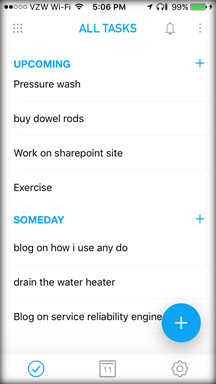 Trying to stay in the habit of writing, and this seemed like a quick post, so here goes; I’m not really in the habit of writing product reviews, but I’ve found this one to be useful, so I thought I’d share.
Trying to stay in the habit of writing, and this seemed like a quick post, so here goes; I’m not really in the habit of writing product reviews, but I’ve found this one to be useful, so I thought I’d share.
Task management is something I’ve always struggled with; I’ve tried various systems from Trello to LeanKit to Kanbanflow, and they’re hard for me to use consistently. At work, I use a homegrown SSRS report connected to our helpdesk system as a kanban board, but it’s clunky for ad-hoc requests. It takes way too many clicks to create a ticket for a simple to-do item like “set up a meeting”.
I recently got an Amazon Echo Dot (and later a Tap), and I was intrigued by the to-do list functionality; suddenly it became quite easy to jot down a quick task for either business or personal work. I just shouted out “Alexa! Add do something awesome to my to-do list”, and was immediately gratified with a task appearing in the Alexa app on my iPhone. Excellent. Except for when I was away from my desk (and my Echo Dot). I could open the Alexa app and add a task item manually, but typing seems so old school. And then I remember, Siri could do reminders too. Guess what? Integration with Any.Do.
Long story short, I can now manage nearly all of my to-do items by voice. If I have a brilliant idea while sitting at my desk, I ask Alexa to note it for me. In the car? Siri’s my friend. The beauty is that they both go to the same repository in Any Do, and I can mark them as completed as I knock them out. The only downside is that the app places them in different lists, but I can view them in one combined list (see screenshots below).


Visibility is only part of the battle; organization is equally important. One of the features that I really like about this product is the “Plan My Day” option. Basically, if you have several tasks scheduled for today, you can run a little wizard to cycle through all of them and decide if they’re really going to get done today (or not), and schedule them accordingly:

I try to keep it to 3 tasks a day; this gives me the flexibility of responding to issues as they come up, and still feeling like I’m getting somewhere. I usually add more tasks as I work, but if I finish with a clean slate (three planned + x unplanned), it’s a good day. Lots more features to explore, including calendar integration, subtasks, and task assignments, but I try to keep it simple. I’ve been pleased with how well the voice integration works, and how natural it is to manage my to-do list now.





 As I’ve alluded to in earlier
As I’ve alluded to in earlier